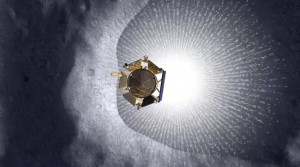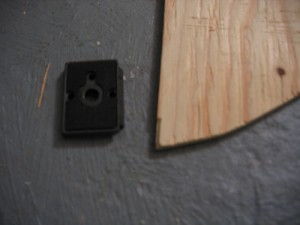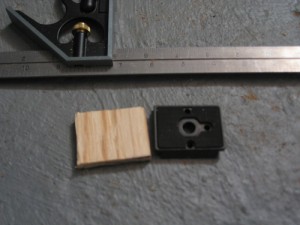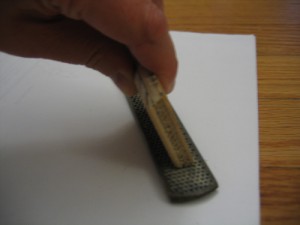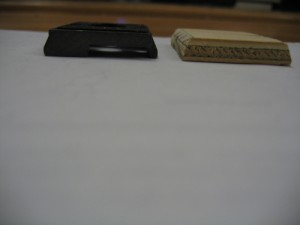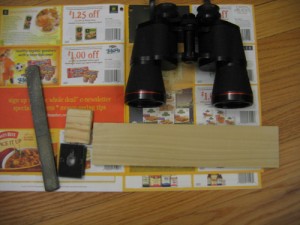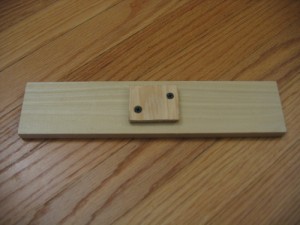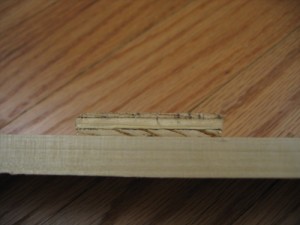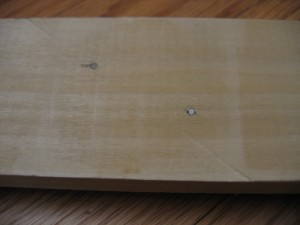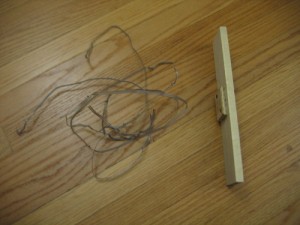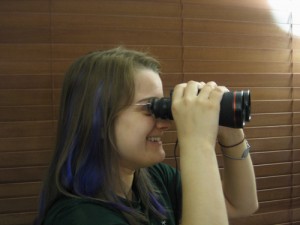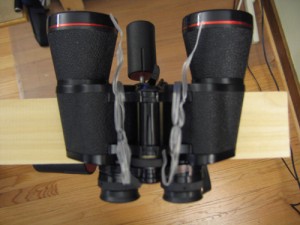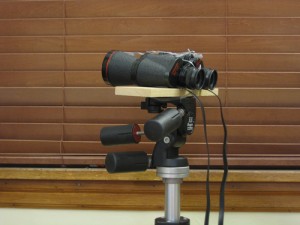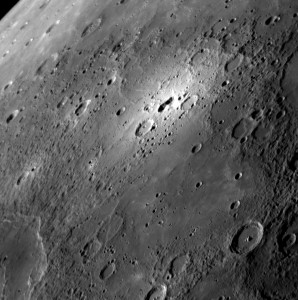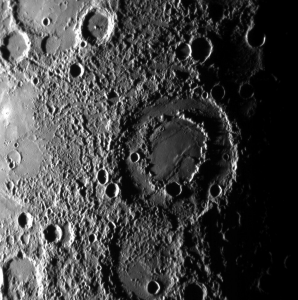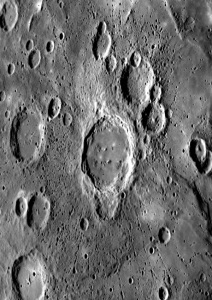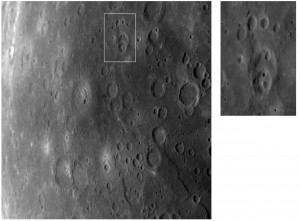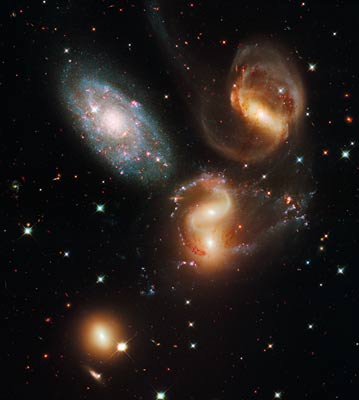 LCROSS Impact
LCROSS Impact
There are two important Moon stories that have happened or are happening in the current couple weeks. They range from exciting (confirmation of the discovery of water on the Moon) to super-exciting (we’re going to slam a spaceship into the Moon on Friday).
Story 1: The Near Future – LCROSS
On Friday October 9, 2009 (4:30am PST) NASA’s LCROSS spacecraft will separate into two parts (the “Centaur” followed by the “shepherding” observing spacecraft) and both will slam into a crater on the Moon, kicking up a plume of material big enough to be seen from Earth with 10- 12-inch telescopes. NASA has requested that astronomers (amateur and professional) observe the plume if possible to help out with the science of the mission. This is one of only a few NASA missions I know of to actively seek the participation of amateurs. Awesome.
This video gives a good look at what is going to happen: LCROSS Impact Animation from NASA
We want to see that plume get large enough to be lit by the Sun, which will cause ice (water), hydrocarbons, and carbon-compounds to vaporize and become more detectable.
Some useful statistics from NASA:
- The first spacecraft to impact is “about the weight of a large SUV, and will impact the Moon at over 9,000 km/h (5,600 mph).”
- The crater it makes will be “about 1/3 of a football field wide and about the depth of the deep end of a swimming pool.”
Story 2: The Recent Past – H2O
While we’re on the topic of the Moon – a couple weeks ago we got pretty good confirmation of water on the Moon at the end of September. Three separate spacecraft confirmed this: Chandrayaan-1, Deep Impact, and Cassini. How much water? That depends on a lot, but so you have something to give out: Emily (of the Planetary Society) says, “10 to 1000 parts per million. This is not a lot. The very highest number corresponds to one liter of water in one ton of lunar rock.”
Where’d I Get My Info?
LCROSS
http://lcross.arc.nasa.gov/impact.htm
http://www.nasa.gov/mission_pages/LCROSS/main/index.html
Where to look on Friday morning!
Water on the Moon – Read Emily’s Posts
http://www.planetary.org/blog/article/00002117/ – Part 1
http://www.planetary.org/blog/article/00002118/ – Part 2
![]()
~ A l i c e !
 Carnivals #121-123
Carnivals #121-123
Carnival of Spaces! Check them out to get your dose of Astronomy.
#121 – Hosted by Next Big Future!
#122 – Hosted by Cumbrian Sky!
#123 – Hosted by Weird Warp! (They even mention this little blog)
![]()
~ A l i c e !
 Binocular Mount
Binocular Mount
When you ask most amateur astronomers (or me) which telescope we recommend for beginners, we will all tell you what you don’t want to hear: don’t buy a telescope first. Buy a pair of binoculars, learn the sky, and then buy a telescope. But that isn’t the answer you wanted, so you go buy a telescope anyway. I understand. I’ve been you. So, if you aren’t going to listen to me: here is my advice on what telescope to buy as a first telescope.
If you are going to listen to me (Hooray!), you may have noticed the gaping flaw in my plan: binoculars are very hard to hold steady, almost impossible in fact. At the end of this article** I’ll tell you the story of the 5-year-old Alice and the shaky binoculars. They do make tripod adapters for binoculars, but they require your binoculars to have certain built-in features. I’d rather you just grabbed the closest pair of binocs and started stargazing. The only truly versatile mount I saw costs at least $50.
I don’t have $50 to spend on something that is supposed to be a quick and cheap introduction to assisted stargazing. I also couldn’t find a guide for building such and item, so my husband and I created one.
Instructions for Building a Binocular-to-Tripod Adapter
I have tried to give the simplest instructions here, aimed at using whatever you have on hand and coming out with a clean finished adapter. You can make this as complicated and fancy as you want, or you can hack it together in fifteen minutes with plywood and glue. Use the skills you have.
Materials
- Binoculars
- Tripod with quick-release plate *
- Small piece of scrap wood (larger than the quick-release plate)
- Medium piece of scrap wood (longer than your binoculars are wide, and narrower than they are deep)
- Two screws (long enough to go through both pieces of wood, thin enough not to split the wood)
- Two fasteners (zip-ties, heavy-duty twist-ties, velcro straps, bendable coat hangers – whatever you have around)
Tools
- Saw (for small cuts on wood and cutting through the screws)
- Wood file (you could also use this to finish your screws instead of the saw)
- Drill
- Pencil (or other way to mark the wood)
Directions
Step 1 – Create a new quick-release plate.
Remove the quick-release plate from your tripod. Cut a piece of the small scrap wood that matches its dimensions as exactly as possible. It is okay if the wood piece is thicker than the quick-release plate, but it cannot be thinner, and the edges must be exactly the same to get a solid lock.
File the angled sides to match the angle of the sides of the quick-release plate. This is where the tripod is going to lock down the plate, so you’ll want to test your angles by inserting the new wooden plate into the tripod head. When it fits neatly and locks firmly into place you’ve done a good enough job.
This is where I had the most trouble. I found that by resting the file flat and holding the wood at the correct angle I was able to file off enough to make my new plate fit.
Step 2 – Attach to the support for the binoculars
As you can see, I’ve carefully chosen a block of wood that is not as deep as the binoculars so there is room for my nose, and it is wider than the binoculars so I don’t have to be too finicky about exactly where I attach the binocs when I get to that step.
Now attach the new plate to the wood you’ve chosen as a support for your binoculars. It should be centered both ways.
Drill two pilot holes for your screws – you don’t want to split your wood after all that work you put into the new plate. If you put them towards opposite corners you’ll get a nice solid connection, with no chance of slippage or spinning. We also countersank our screws, which you might want to do because it keeps the bottom of your quick-release plate flush with itself.
File off the ends of your screws so they don’t poke up and scratch your binoculars.
Ta-da! You’re done!
Oh wait – you want to know how to USE it now?
Step 3 – Using your finished mount
Pull out your binoculars and point them at something far away. Focus them and get them all nicely-adjusted for your eyes. It is important that you do this first, or you may end up fastening your binoculars in a position that is out-of-alignment for your eyes.
Attach the mount to your tripod, and rest the binoculars on the mount. Loop your fasteners around the middle of the binoculars and underneath the mount. Fasten them securely, but not so tightly as to change the careful adjustments you made to focus and align the binoculars.
Check – do you feel comfortable tilting the tripod head from side-to-side and up and down with the binocs attached the way they are? If not, you need to fasten them more securely. If so, then take it outside and start looking up!
Notes
*No quick-release plate?
If you have a tripod that does not have a removable quick-release plate, you’ll need to attach a 1/4 by 20 nut in the middle of the support wood instead of creating a wooden quick-release plate. (To get the right size nut, just take your tripod either to your stash of random fasteners or to the hardware store and find one that fits it – though 1/4 by 20 is almost entirely standard). I had a thought about this involving a hexagonal hole exactly the size of the nut and some amazing glue. This to That recommends LePage’s Metal Epoxy. I didn’t go through with this idea, so the execution is left as an exercise to the reader. please let me know if you come up with an easy and functional solution!
**Alice and the Shaky Binoculars
The year was 1986. The month was cold. One night, Mom and Dad bundled 5-year-old Alice and her baby brother, Nils, into the car. Maybe Uncle Ron came too, or maybe he was in a different car. In any case it was clearly a big occasion. Together they drove and drove and drove. The night got darker and darker. Finally, they all pulled over on the side of a steep hill. Alice got out of the car while Mom and Dad got Nils.
Dad got out some binoculars. Mom reminded Alice that we were looking for Halley’s comet. The only thing that really mattered about Halley was that of everyone on the hillside that night, only Alice and Nils would get to see the comet twice.
While Mom turned Nils to face the sky, Dad crouched down to help Alice look through the binoculars. A shiny white object streaked and wobbled through the field of view.
“I see it! I see it!” said Alice, excited.
Once everyone was thoroughly cold, they all got back in the car and drove home – possibly stopping at Shari’s or Denny’s for something warm to drink.
That memory is still with me, which is the most important part of the whole experience. Now I know that wasn’t Halley’s comet I saw in those binoculars, it was a star, or maybe even a streetlight – wobbling past because I couldn’t hold the binoculars still enough. If only we’d had this binocular tripod mount!
At least I know that some of the photons bouncing off Halley’s comet did bounce into my eye, just not enough of them for my brain to register. Oh well, next time. Here I come 2061!
Have fun with your new binocular tripod mount!
![]()
~ A l i c e !
 MESSENGER’s 3rd Flyby of Mercury
MESSENGER’s 3rd Flyby of Mercury
NASA’s MESSENGER just did its third flyby of Mercury on September 29th, 2009. It will enter orbit in March of 2011. Here are a few discoveries, with some personal notes and thoughts.
Bright Spot
Interestingly, this bright spot has been seen and photographed only three times – twice by MESSENGER, and the first time from the ground. That ground image was by Ron Dantowitz, one of my coworkers from the Museum of Science! He used the Mt. Wilson Observatory to collect an incredible image.
The light parts are probably kicked-up material from the basin in the middle. Due to the shape and color, the basin may or may not be volcanic in nature. They’re still studying.
Double-Ring Crater
Ahh, beautiful. Double-ring craters are an indication of a high-force impact – usually a very massive meteorite. There is a “ripple effect” in the rock – like dropping a pebble in a pond – except you’re dropping a rock on a planet. Sometimes you even get a “splash-back” which forms a peak in the middle of the crater.
The rock of the surface of the planet is made molten by the force of the impact, and resolidifies – freezing the ripples in place. You don’t want to be nearby when this happens.
Crater Ejecta and Secondary Impact Chains
How do you get a string of craters in a very straight line? No … stop. Consider for a moment. You know what? I’m not going to tell you to the end of the post in order to FORCE you to think about it.
Paw Print!
I couldn’t not include it – it is just too cute!
Now – how did this happen?
You know, for all of the great ideas you just had, this set of craters is coincidence (like the smiley-face crater on Mars). Pretty cute though, right?
Crater Ejecta and Secondary Impact Chains – Continued
Okay, I hope you came up with some creative answers. Often they are caused by a “splash” kicked up when a meteorite forms a crater (in this case called a primary crater), and some of the material tossed up is big enough that when it comes back down it makes a secondary crater.
Now, instead of just one rock being kicked up and away from the primary impact, several are. They all fly off in the exact same direction (away) and when they come down each one makes a secondary crater – and they all occur in a line.
![]()
~ A l i c e !
 Equinox Event
Equinox Event
Tomorrow (Tuesday, September 22) is the Fall Equinox here in the Northern Hemisphere. I’m planning to head over to Solstice Park in West Seattle (7400 Fauntleroy Way SW) to watch the Sun set over the Equinox marker at 7:06pm.
If you’d like to join me, please do – and your whole family is welcome too. If it is clear I’ll bring my new Galileoscope and we’ll see if we can’t find a few neat sky objects after it begins to get dark. If it isn’t clear, I’m still going to the park, but I won’t be bringing my telescopes.
Consider it your “science fix” while Pacific Science Center’s exhibits are closed this week – but don’t forget, we open again on Saturday all clean and shiny!
![]()
~ A l i c e !
 September-October Sky 2009
September-October Sky 2009
September-October 2009 Starmap
(With an activity! If you complete it, you should send me a photo of yours, I’d love to see them!)
Notable Sky Objects
HEY ALICE! I SAW …
In every season’s sky there seems to be an object that is spectacular enough that people come up to me saying “Hey Alice, last night I saw…” I guess it is a little rude of me, so I apologize, but I can usually interrupt the sentence at this point and tell them what it was – which makes me seem almost psychic. Well sorry, but it isn’t magic, its pattern recognition. After three people have asked me about the same object, I naturally assume the next few will be asking about the same thing. I love supporting people’s excitement about the sky, and I love it that you come to me to ask what you saw – so keep it up, but just in case you want to make a guess for yourself first (or impress your friends), this season’s “Hey Alice!” object is the spectacular and bright Jupiter.
JUPITER
Jupiter will be highly visible most of the night in September and October. It will be rising in the Southeast, near the constellation Capricorn. If you pull out some binoculars and steady yourself against something, you should be able to pick out the moons of Jupiter, just like Galileo did.
MERCURY and SATURN
Mercury and Saturn are too near the Sun from our point of view to be easily visible. You might catch a glimpse of Saturn in the early morning in very late October near the eastern horizon.
MARS and VENUS
In early September: Mars is rising about 1am in Gemini, and Venus is rising around 4am in Cancer.
In late October: Mars is rising a little after midnight in Cancer. Venus will not be visible.
EVENTS
September 30 – MESSENGER makes its third flyby of Mercury, and soon after that there will probably be some awesome new photos of this tiny, hot, rocky planet.
October – Don’t miss The Halloween Show in the Willard Smith Planetarium at Pacific Science Center. We’ll be bringing back the newly spookified version of the historical astronomical connections to our modern candy-riffic holiday. It will be weekends at 2:30 – you can get tickets at our ticketbooths or online.
CARNIVALS OF SPACE
I’ve missed a few, but you shouldn’t. Check out #112, #113, #114, #115, #116, #117, #118, #119, and #120!
New Constellations
A recent survey of attendees of the Willard Smith Planetarium suggested that visitors would like to hear even more about current science and new discoveries. I still want to tie that back to the constellations we’re viewing whenever possible, so in this bi-monthly Sky Update I have attempted to share a piece of current science that can be associated with each constellation. I haven’t succeeded, I only found time to put in 3 things but they’re pretty cool, and I’ll keep building on this.
PISCES – The Fish
SCIENCE: M74 is one of the most beautiful face-on spiral galaxies I have ever seen.
MYTH: We often use the loop at the end of Pisces as the wings of Pegasus. Technically, these stars are in Pisces – but it sure helps to see Pegasus as a winged horse.
Returning Constellations
AQUILA – The Eagle
CURRENT: NASA’s new moon lander will be called Altair – after the brightest star in Aquila. Neat that it is a star in the constellation of the Eagle, when the first lander that landed on the Moon was also called the Eagle.
ANDROMEDA – The Princess
PERSEUS – Perseus
PEGASUS – The Flying Horse
CURRENT: On September 9th (2009) Hubble released four new images taken after the last servicing mission. They are breathtakingly beautiful as usual – but the one of Stephan’s Quintet was taken while Hubble was pointed at the constellation Pegasus. This is a great opportunities to talk about types of galaxies, interacting galaxies, or the size of the universe.
CAPRICORNUS – The Sea Goat
DELPHINUS – The Dolphin
LYRA – The Lyre
CYGNUS – The Swan
CURRENT: NASA’s Kepler mission (looking for Earth-like planets around other stars) is pointed at Cygnus, and will stay pointed between Cygnus and Lyra for the duration of its mission.
BOÖTES – The Herdsman
HERCULES – Hercules
CORONA BOREALIS – The Northern Crown
CEPHEUS – King Cepheus
DRACO – The Dragon
URSA MAJOR – The Great Bear
URSA MINOR – The Little Bear
CASSIOPEIA – The Queen
“Tiny” Guys
Going for the Gold? Here’re this month’s itty-bittys.
ARIES – The Ram
AQUARIUS – The Water Bearer (not that small, but not on our map)
PISCES AUSTRINUS – The Southern Fish
MICROSCOPIUM – The Microscope
SERPENS – The Serpent
SCUTUM – The Shield
VULPECULA – The Fox
SAGGITA – The Arrow
EQUULEUS – The Horse
CAMELOPARDALIS– The Giraffe
LACERTA – The Lizard
TRIANGULUM – The Triangle
LYNX – The Lynx
Wondering where I’ve been? Yeah, sorry about that. There was this grant, this major project, and this conference. I’ve gotten sick of seeing apologies for not posting all over the internet though, they remind me too much of the permanent “Under Construction” labels and animated gifs that were so prevalent on the web in the 90s. They aren’t usually interesting, I want to hear what the bloggers I follow really have to say, not that they’re sorry for not posting. So, I am actually sorry, and I hope I haven’t lost too many of you with such a long break, but I’ve hidden that apology down here at the bottom so you aren’t subjected to it if you don’t want to read it. :) Clear skies to you – or at least clear internet skies if you live somewhere with 200 days a year of cloudcover …
![]()
~ A l i c e !
 Quick Updates: Kepler, Saturn, Perseids, Jupiter
Quick Updates: Kepler, Saturn, Perseids, Jupiter
Perseids:
The Perseids peak tonight after midnight. They’re dust- and sand-sized debris left in our path from comet Swift-Tuttle. The air compressing in front of each meteor generates enough heat that the debris burns up and we see a streak of light.
Kepler:
The Kepler mission (looking for Earth-like planets around other stars) has just proved it definitely can detect planets, with more detail and precision than other methods. Kepler observed the planet HAT-P-7, which orbits its star once every 2.2 days, and was able to detect the atmosphere of the planet, and measure the daytime temperature at 4310 degrees F. Ouch.
Saturn:
Saturn’s rings are edge-on from our point of view, which happens every 15 years when Saturn reaches its equinox. According to JPL that day was yesterday, August 11, though the rings will stay mostly edge-on for a while yet.
Jupiter:
I’m quite late off the mark on this one, but something crashed into Jupiter not too long ago. On July 19th an amateur astronomy (Anthony Wesley) found this extra dark spot on Jupiter, and later professional astronomers followed up on his observations with Hubble. With Hubble they can watch as the debris plume evolves, and make better estimates about the size of the impacting object (several hundred meters across).
There is a standing hypothesis that Jupiter, being large, helps clean up the debris in the solar system. It attracts more asteroids and comets, leaving the inner solar system clearer and thus making impacts on Earth less likely.
Want More?
Where’d I Get My Info?
![]()
~ A l i c e !
 Some Links
Some Links
Life comes in waves – busy waves, and waves when you have lots of time to blog. You get one guess which wave I’m in now.
Meanwhile, I will leave you with some good links.
1. There is another Alice! Not only that, there is another Alice involved in informal astronomy education. Not only THAT, there is another Alice in the Pacific Northwest who is highly involved in informal astro ed. So, if you’re looking for Alice’s Astronomy a Go Go … you’re in the wrong place, you’re at Alice’s AstroInfo. But you should definitely head over there and check out her podcasts, she’s got some neat stuff.
2. Carnival of Space #112: Out of the Cradle celebrates the Moon Landing
3. Carnival of Space #113: Dynamics of Cats hosts one all about extraterrestrial impacts
4. Carnival of Space #114: Ultra Cheap, from Cheap Astronomy
And don’t miss Kepler’s announcement of their proof of concept: http://kepler.nasa.gov/press/earlyresults.html
![]()
~ A l i c e !
 Carnival of Space
Carnival of Space
21st Century Waves has this week’s Carnival of Space – #111! It is a celebration of the anniversary of the Apollo 11 launch! Woo!
Also, for celebrating the Moon landing, We Choose the Moon might be cool.
 A Puzzle and Two Carnivals
A Puzzle and Two Carnivals
Sunday mornings I enjoy playing the NPR’s puzzler with my family. I thought you might enjoy a puzzle/mindgame too.
It was late one December, and I was out for a walk with my family. The full moon was rising. It was rising almost due Northeast. Why?
This puzzle helped me solidify my understanding of the celestial sphere, so if you already completely understand the celestial sphere it might not be much of a puzzle – but if you’re still learning about it, figuring out this puzzle could be a turning point for you.
I’ll leave moderated comments on for this post: if you leave the answer I won’t approve the comment, but I’ll e-mail you a reply. You are welcome to leave further questions in the comments as well, but hints will only come to you via e-mail, I will not post more hints here.
Also, there are two Carnivals of Space for you to check out:
109, hosted by Discovery Space
![]()
~ A l i c e !

